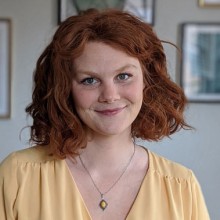The science of artifact preservation: Cool storage solutions
In our modern, everyday lives, we rely on cold storage solutions all the time — often without really thinking about it. For example, imagine leaving a pint of strawberries on the kitchen counter in the summer, rather than refrigerating them. They will be much quicker to spoil in the heat compared with storing them in the fridge.
Just as it plays a critical role in preserving our food supply, cool storage is also a key preservation principle for museums and archives, which have a long history of preserving photographic and cinematographic collections. Maintaining objects in cool storage — at a temperature between 5⁰C and 10⁰C — halves the rate of chemical processes that would occur at room temperature. These processes, such as hydrolysis and oxidation, can lead to the degradation of our artifacts and materials. The lower the temperature, the slower the chemical reactions can be. Sometimes objects are even stored very cold or below zero — between 0°C and -20°C — but not all materials can handle these temperatures long term.
As its name suggests, cool storage stays above the freezing point of water, allowing a larger variety of objects to be stored in conditions which still benefit from slower reaction rates. As the materials we use in our everyday lives change, so do museum collections. Cool storage is now widely utilized for modern materials — particularly plastics and rubbers.

An example of plasticizer migrating to the surface of the charging cable and lacquered disk.
Preserving modern materials
In your home kitchen, you can begin creating a dish with flour and water, but depending on how you work, flavour, and shape the dough, it can turn into wildly different products. For instance, the addition of yeast will make a leavened bread, but if you omit yeast and add egg, you have dough to make pasta.
Plastics and rubbers — which now show up in a large proportion of historic, technological, and scientific museum collections — are like a dough. There are a variety of manufacturing processes for polymers, and a seemingly infinite number of fillers and additives which have been used in plastics, depending on the intended purpose of the object.

An example of plasticizer migrating to the surface of the lacquered disk.
Unfortunately for conservators, these additives and fillers can also contribute to the deterioration of the plastic itself. Knowing the exact composition of different variations of plastics and rubbers is nearly impossible without analytical equipment, but the signs of deterioration that an object is displaying can give conservators helpful clues towards estimating its composition. Chemical spot testing can also be conducted to identify different plastics, such as diphenylamine tests for cellulose nitrate (film, fake ivory), or the Beilstein test for identifying polyvinyl chloride (tubing, toys).
Slowing the effects of degradation
Deterioration often starts long before the surface of the object shows any signs to the naked eye. Light, temperature, and humidity are all agents that can kick off the process, although deterioration can also begin on its own if the plastic is particularly unstable, such as with cellulose-based plastics. Often, objects have seen a lifetime of use, damage, and unfavourable conditions prior to being acquired by a museum, meaning conservators are already playing catch-up by the time an object is acquired.

A sample of rubber bicycle tires.
In the Ingenium collection, there are a wide variety of plastic and rubber composite objects, many of which are good candidates for cool storage. Composite objects are made up of two or more distinct materials that interact with each other differently, and thus degrade differently as well. One example of an object destined for cool storage is a set of bicycle tire samples from the 1930s. Manufactured in Italy by Azioni Soc., these samples are composed of rubber on a cardboard backing. In non-ideal storage conditions, the rubber can begin to harden and crack, and even crumble apart. Preventive conservation comes into play here; by sending this object to cool storage, the effects of degradation on the rubber tire samples can be slowed, preserving the condition of the objects for a longer period of time. This means that the rubber will remain pliable and soft, and can showcase the intended nature of the material.

A sphygmomanometer composed of plastics and rubber.
Another example of a good candidate for cool storage is a sphygmomanometer, better known as a blood pressure cuff. This object is a great example of a composite object; it is made of a plastic vinyl cuff with a dark, pliable plastic tubing and a rubber bulb. While all of these materials are different, they all benefit from being in cool storage so they can be preserved for future use and observation.
At the new Ingenium Centre in Ottawa, a cool storage room has been built to hold a variety of 3D objects. With a set point of 5⁰C ± 3⁰C, the conditions in this cool storage facility will slow the chemical degradation rate of plastic objects stored within. By also maintaining a stable humidity point at 25%RH, as well as restricting ultraviolet light, the cool storage room is an excellent tool for preventing further degradation of the objects. Currently in the world of plastics and rubbers, there is no known process for reversing chemical degradation. Here, cool storage allows for the preservation of these objects that would otherwise begin to break down, and no longer be true to their original material selves.
Have more questions about the conservation of plastics or cool storage? Connect with the Ingenium conservation team on Twitter @SciTechPreserv



















